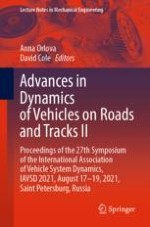This book offers a snapshot of the latest research and developments in road and railway vehicle dynamics. Gathering peer-reviewed contributions to the 27th Symposium of the International Association of Vehicle System Dynamics (IAVSD), held online on August 17–19, 2021, from Saint Petersburg, Russia, it offers extensive information for both researchers and professionals in the field of ground vehicle dynamics, control and design. It covers cutting-edge methods and solutions for solving ground vehicle system dynamics-related problems, concerning control and monitoring, performance, safety and braking of road and rail vehicles, including electric and autonomous ones. Further, it reports on significant advances in vehicle design, and important applications to improve ride comfort. Overall, the book provides academics and professional with a timely reference guide on theories and methods to understand, analyze and improve vehicle stability and dynamics in a broad range of different operating conditions.
Chapter "Experimental Validation of a Semi-physical Modelling Approach of the Influence of Tyre Rotation on the Vertical Tyre Force Transmission and Tyre Kinematics" is available open access under a Creative Commons Attribution 4.0 International License via link.springer.com.
